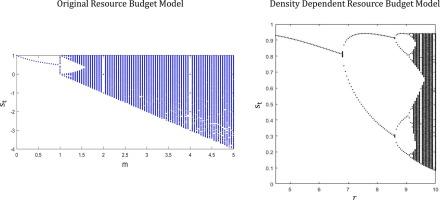Journal of Theoretical Biology ( IF 1.9 ) Pub Date : 2020-09-21 , DOI: 10.1016/j.jtbi.2020.110498 Shadisadat Esmaeili 1 , Alan Hastings 2 , Karen Abbott 3 , Jonathan Machta 4 , Vahini Reddy Nareddy 5

|
Alternate bearing, seen in many types of plants, is the variable yield with a strongly biennial pattern. In this paper, we introduce a new model for alternate bearing behavior. Similar to the well-known Resource Budget Model, our model is based on the balance between photosynthesis or other limiting resource accumulation and reproduction processes. We consider two novel features with our model, 1) the existence of a finite capacity in the tree’s resource reservoir and 2) the possibility of having low (but non-zero) yield when the tree’s resource level is low. We achieve the former using a density dependent resource accumulation function, and the latter by removing the concept of the well-defined threshold used in the Resource Budget Model. At the level of an individual tree, our model has a stable two-cycle solution, which is suitable to model plants in which the alternate bearing behavior is pronounced. We incorporate environmental stochasticity by adding two uncorrelated noise terms to the parameters of the model associated with the nutrient accumulation and reproduction processes. Furthermore, we examine the model’s behavior on a system of two coupled trees with direct coupling. Unlike the coupled Resource Budget Model, for which the only stable solution is the out-of-phase solution, our model with direct coupling has stable in-phase period-2 solutions. This suggests that our model might serve to explain spatial synchrony on a larger scale.
中文翻译:

与密度有关的备用轴承资源预算模型
在许多类型的植物中都可以看到,交替轮作的产量是可变的,且具有强烈的两年期模式。在本文中,我们介绍了一种替代轴承行为的新模型。与众所周知的资源预算模型相似,我们的模型基于光合作用或其他限制资源积累和繁殖过程之间的平衡。我们在模型中考虑了两个新颖的特征:1)树的资源库中存在有限的容量,以及2)当树的资源水平较低时,产量较低(但非零)的可能性。我们使用密度相关的资源累积函数来实现前者,而通过消除资源预算模型中使用的定义明确的阈值的概念来实现后者。在单棵树的层次上,我们的模型具有稳定的两周期解,这适用于对交替轴承行为明显的工厂进行建模。通过将两个不相关的噪声项添加到与养分累积和繁殖过程相关的模型参数中,我们纳入了环境随机性。此外,我们在两个具有直接耦合的耦合树的系统上检查模型的行为。与唯一的稳定解决方案是异相解决方案的耦合资源预算模型不同,我们的直接耦合模型具有稳定的同相周期2解决方案。这表明我们的模型可能有助于更大规模地解释空间同步性。通过将两个不相关的噪声项添加到与养分累积和繁殖过程相关的模型参数中,我们纳入了环境随机性。此外,我们在两个具有直接耦合的耦合树的系统上检查模型的行为。与唯一的稳定解决方案是异相解决方案的耦合资源预算模型不同,我们的直接耦合模型具有稳定的同相周期2解决方案。这表明我们的模型可能有助于更大规模地解释空间同步性。我们通过将两个不相关的噪声项添加到与养分累积和繁殖过程相关的模型参数中来纳入环境随机性。此外,我们在两个具有直接耦合的耦合树的系统上检查模型的行为。与耦合资源预算模型(唯一的稳定解决方案是异相解决方案)不同,我们的直接耦合模型具有稳定的同相周期2解决方案。这表明我们的模型可能有助于更大规模地解释空间同步性。











































 京公网安备 11010802027423号
京公网安备 11010802027423号